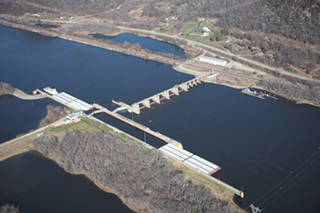The final budget of the Obama presidency offers a frosty farewell to the waterways industry, proposing deep cuts in programs that support inland navigation, and again raising the unpopular and never approved plan to impose lockage fees on commercial users of the waterways.
The FY 2017 budget, submitted Tuesday to Congress, proposes an almost 30% cut in the current budget of the U.S. Army Corps of Engineers, which oversees inland navigation maintenance and improvements, to $4.6 billion from $5.9 billion. Taking the biggest hit would be the Corps' construction account, with a drop of 41%, while operations and maintenance would be shaved nearly 14%, according to calculations provided by the Waterways Council, an industry-funded advocacy group.
The budget also proposes to raise $1.3 billion in an inland waterways user fee, similar to the plan offered in previous years — and by previous administrations — that has been solidly rebuffed by Congress as unfair and unworkable.
Waterways activists criticized the budget proposal and vowed to fight the cuts in Congress.
"It's a cynical insult to all the good that the civil works program has done for the nation," said John Doyle, a Washington attorney with Jones Walker LLP who works with the Waterways Council and is a former top official at the Corps of Engineers and congressional aide.
Doyle said in an email exchange that Congress set a much more supportive direction for waterways funding in last year's omnibus budget, and will likely ignore the president's proposal and continue with the higher spending levels provided in the past.
The president's $4.1 trillion budget faces a lengthy review before a hostile GOP-dominated Congress. Republican leaders said this week that they will largely ignore or rewrite the document. The new fiscal year begins Oct. 1.
Republicans were especially irked by Obama's plan to place a $10 per barrel tax on crude oil. If passed, analysts say the fee could add another 24 cents per gallon to gas prices, and encourage pullbacks in energy exploration and production, which has already been hit hard by falling oil prices. Such a policy could have continued negative consequences for workboats serving the offshore oil industry in the Gulf of Mexico.
There would also be continuous budget woes for the already underfunded Coast Guard. Under the plan, the service's budget would be trimmed from the current $11.1 billion approved by Congress last year to $10.3 billion — a sum far lower than what studies have said is needed for the Coast Guard to recapitalize its aging fleet and fulfill its various missions, from search-and-rescue to maritime security.
On the plus side, the budget recognizes the importance of improving the Coast Guard's ice-breaking capabilities by allocating $150 million to complete design work on a new icebreaker. The United States currently has only two operating ice breakers (the Polar Star, a heavy ice breaker and the Healy, a medium icebreaker used mostly for scientific research), while the rival Russians have 27. Climate change has opened up the Arctic to more commercial shipping, research and energy exploration, causing competition between neighboring nations for access there.
Also proposed is $100 million for detailed designs of the Offshore Patrol Cutter, $130 million to convert C27J aircraft for Coast Guard use, and $240 million to build four Fast Response Cutters.
For the Maritime Administration, the White House requests $428 billion, an increase of $400 million. Nearly $100 million is planned for continued repairs and improvements at the U.S. Merchant Marine Academy in Kings Point, NY. This would include replacing the bridge simulators, IT upgrades, improving security, repairing the seawall and renovating academic buildings. Funds would also continue to flow to support operations at the six state maritime academies and keep their training ships afloat.
Marad's budget would continue the $5 million effort started last year to design a new purpose-built "National Security Multi-Mission vessel" that would gradually replace the aging training vessels used at the academies. Obama is asking for another $6 million to fund an "independent requirements and alternatives analysis" for cadet training needs to further the project.
Once the design is finished, construction funds would have to be appropriated. The first vessel will be built for the SUNY Maritime Academy in New York to replace the Empire State VI, which is 53 years old. The average age of training vessels at all the schools is 37 years, according to Marad.
The new multi-mission vessel would be outfitted for cadet training, but would also be used during national disasters, emergencies and humanitarian missions. Academy ships were put into service during Hurricanes Rita (2005) and Sandy (2012).
Lastly, the budget offers $19 billion for a national initiative to improve cybersecurity. Cyber intrusions have been identified as a big threat to the maritime sector, but it's not yet clear how this program might help mitigate threats to the nation's ports and vessel operations.




